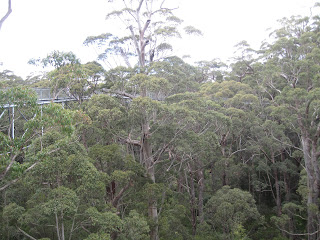We only managed to get to the first scenic highlight inside the National Park, the Moss Garden, and that was seven kilometres in total, some of it quite steep.
A further 1.8 kms along the main track, then 600 metres in and finally up a ladder is the Ampitheatre, which we would have liked to get to, but Eric's legs just couldn't manage quite that much. Still further along is an aboriginal art gallery. Nevertheless, just walking along the track, seeing the stately white-trunked trees outlined againt the escarpment and listening to the birds was very enjoyable.
The start of the main track:
 |
| Large stepping stones make crossing Carnarvon Creek easy |
 |
| From the middle of the creek |
 |
| And looking the other way |
Along the main track:
At the start of the main track is a short two kilometre 'nature trail' walk:
We camped at Takarakka Bush Resort which is about four kilometres from the National Park Visitor Centre. It's a pleasant spot and we picked a good time to visit. The weather was warm but mostly overcast, so good for walking, though we did have one day when it poured rain. The resort manager dismissed the downpour as "just a shower to settle the dust". A bit further down the road towards the park is another accommodation place and restaurant for non-campers (Carnarvon Gorge Wilderness Lodge).
Between the camp and the Visitor Centre, but still technically part of the Gorge (I think) are a number of places to visit which involve shorter walking distances.
 |
| Rock Pool |
Mickeys Creek Gorge track:
So even though we didn't get very far along Carnarvon Gorge proper, we still managed to do quite a bit and thoroughly enjoyed the whole experience.
.jpg)
.jpg)
.jpg)









.jpg)
.jpg)


.jpg)
.jpg)
.jpg)
.jpg)
.jpg)



































